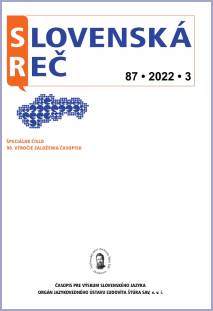Etymologické výskumy v časopise Slovenská reč
Research on Etymology in the Slovenská reč Journal
Author(s): Martin Diweg-PukanecSubject(s): Language studies, Language and Literature Studies, Theoretical Linguistics, Lexis, Semantics, Historical Linguistics, Western Slavic Languages
Published by: SAV - Slovenská akadémia vied - Jazykovedný ústav Ľudovíta Štúra Slovenskej akadémie vied
Keywords: accentology; etymology; laryngeal theory; lexicography; onomastics; semantics; Slovenská reč
Summary/Abstract: The aim of this paper is to present the articles that were published during the years 1932-2022 in the Slovenská reč journal and dealt with etymological research. Etymological research in the entire period of the journal’s existence cannot be reduced to a single line of development from a theoretical point of view, which is visible, among others, in the list of the most prominent etymologists of the Slovak language of the period who carried out a publishing activity in this linguistic field on the pages of Slovenská reč: V. Šmilauer, J. Stanislav, F. Kopečný, V. Polák, Š. Ondruš, and Ľ. Králik. For example, the youngest of the mentioned linguists, Ľ. Králik, belongs more to the conservative wing of etymological research, while, for example, Š. Ondruš, who can be regarded together with Ľ. Králik as the most prolific etymologist in the journal, rather to the modernist wing. This is true if we consider the main criterion of modernity to be a positive or negative attitude towards the possibilities of the laryngeal theory, as was thought in Slovak linguistics about half a century ago. However, if we were to take the modernity of the continuity of the research by the accentologist C. Stang (Slavonic accentuation, 1957) as a criterion, as it is supposed nowadays, we would have to admit that the etymology of the Slovak language in the journal is conceptually more in line with the most important etymological dictionary of Slavic languages, Etimologicheskii slovar slavianskikh yazykov, which did not reflect the work of C. Stang, nor did it follow the research of the Moscow accentological school (V.M. Illich-Svitych, V.A. Dybo, and others). Since the etymological research on the pages of Slovenská reč does not fully follow C. Stang’s accentological work or the works of the Leiden accentological school of F. Kortlandt, which consider Stang’s accentology as their starting point, it may nevertheless look like a certain deficit in the perspective of the large production of new etymological dictionaries of the Leiden school. The example of Š. Ondruš, today’s undecided discussions among accentologists, but especially the modest contribution of accentology to etymology (e.g. in many respects the excellent Slavic etymological dictionary by R. Derksen, a member of the Leiden school, contains new orthography rather than innovative interpretations) show that modern Balto-Slavic accentology is rather a dead end for the etymology of the Slovak language. Therefore, the articles in the field of etymological research published during nine decades in Slovenská reč certainly cannot be regarded as outdated, quite the contrary. Throughout the entire period they have brought ideas reflecting the state of knowledge at the time, but often also very progressive ideas. These ideas, however, seem to have been exhausted at some point and a moderate, more conservative line of etymological research was established, reflecting both the Czech-Slovak as well as Slovak traditions in Indo-European and Slavic studies.
Journal: Slovenská reč
- Issue Year: 87/2022
- Issue No: 3
- Page Range: 389-401
- Page Count: 23
- Language: Slovak

